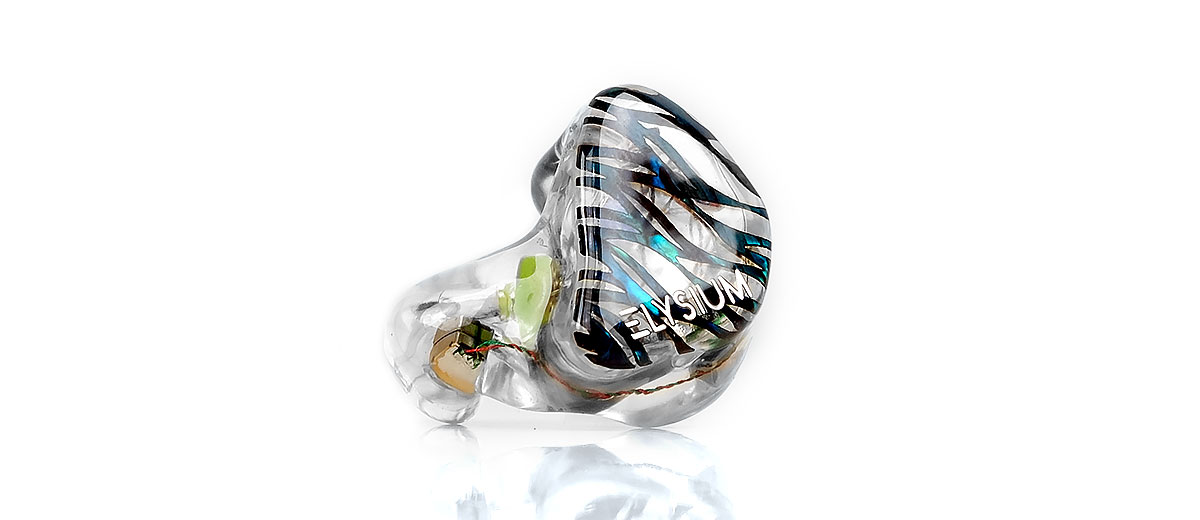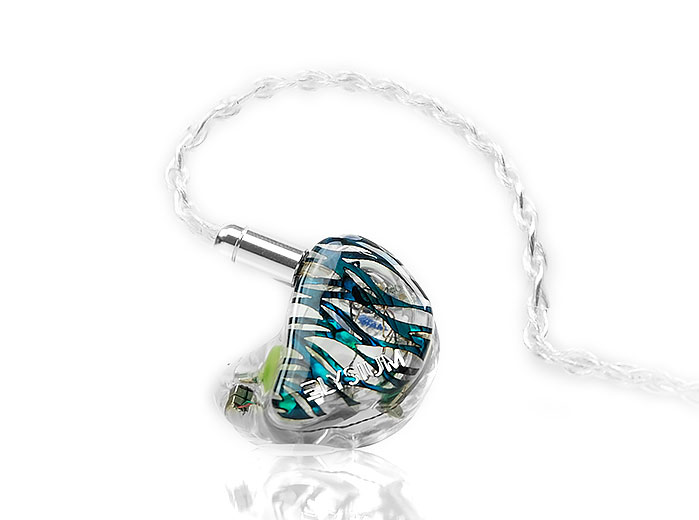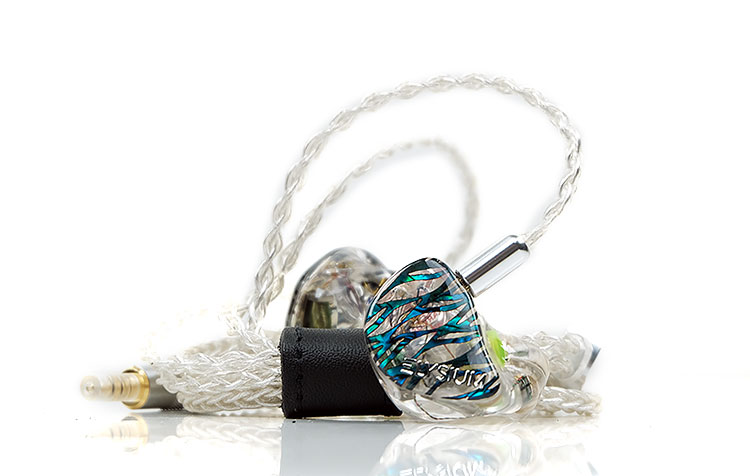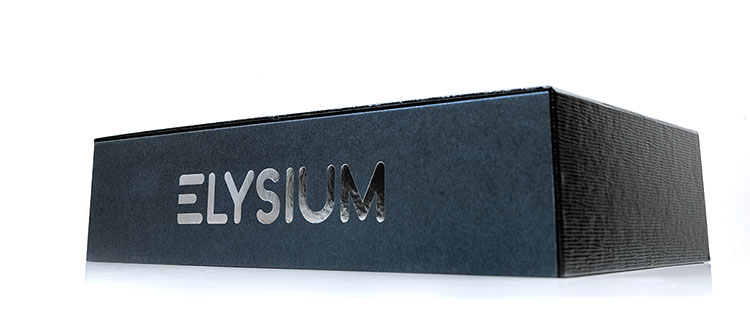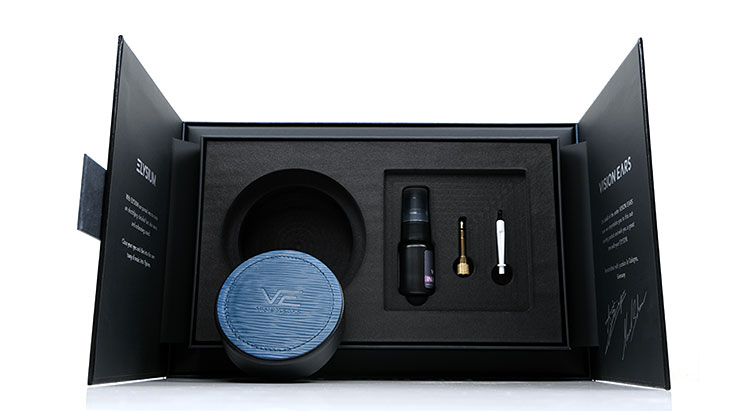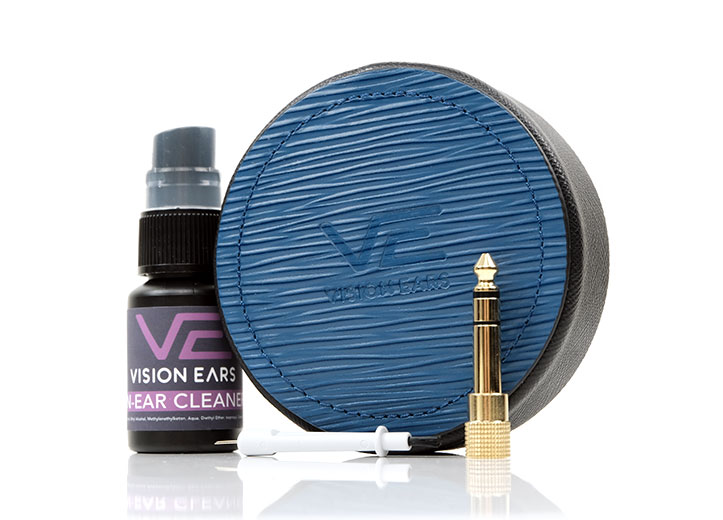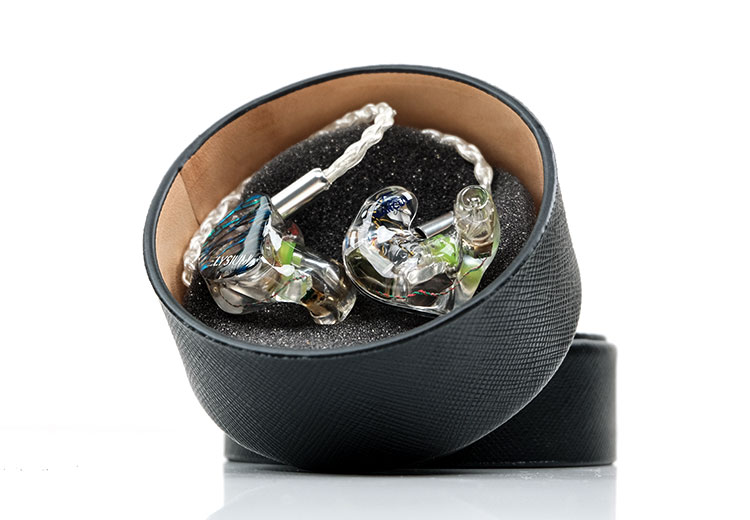Meet the Elysium
Design
This design is beautiful. At first, I came to Amin & Marcel with my own design thoughts (moribund such as they are), but in the end, they convinced me to try the house design or the one they use for all the ad work. Since I had it in my hand in Singapore I thought well yup this might be ok.
However, when I received it a few weeks back and did the shots it just looks so damned interesting than what I had originally in mind for a design. You have color on the outside, color on the inside (HALC green), and a transparent shell to show off a collage of wiring colors on top of it.
The guys simply call it the Elysium design so there is no alternative coding on the Customizer online tool. It will cost you 130 EUR though as a premium design. The top blue tiger-like stripes really do a top job of offsetting an otherwise monotone transparent shell and compliment the lime green effect of the HALC chamber behind it nicely.
Finishing
On top of that, as always with Vision Ears, the finishing on the acrylic body is flawless. You will not find a bubble, scratch, or big seam anywhere on the Elysium shell.
Both the shell and the plate are coated with a thick but clean acrylic finish and given a high-quality UV lacquer coating that makes everything feel pleasantly smooth feel, particularly around the nozzle which is normally where the first contact with your ear canal is made.
Horn Principle
They have also continued with the horn design principle for their nozzles with a triple bore variable-length tubing system a few mm back from the exit point of the main acrylic bore opening. Vision Ears has been using horn designs now for quite some time, going back to the VE6 we reviewed many years ago.
The large open bore allows Vision Ears to fine-tune and develop the readily mixed multi-bore sound before it leaves the chamber and into the ear canal. In doing so, they can tweak Elysium’s high-frequency extension a little further than what is possible with a traditional individual tubed bore design using the same drivers.
Cables & Connectors
The Elysium, as with all VE custom monitors, uses a standard 0.78mm 2-pin connection flush with the body rather than a recessed socket. Note, there is no L or R on the 0.78mm 2-pin connectors but rather a single groove on the left connector to ensure you can channel match properly.
These have been rock solid for me down through the years and not one of them has sunk, even the VE6 which is over 4 years old now.
I am not a huge fan of recessed sockets because it increases the risk of poor cable fits if the pin sockets are at a slight angle or the recessed bay is too tight. I have had that before on the AAW W900 which limited the cables I could use with ease.
Stock Cable
The cable is an in-house design but it looks pretty good to me and at a much higher level than the older stock Plastics One type OFC 4-wire variants from a few years ago.
This is a 28AWG 8-wire silver-plated SPC wire insulated in 200d Kevlar for each wire and wrapped in a very pliant translucent PVC jacket.
It is thicker than your normal 4-wire but the 28AWG rating keeps it nice and light. The braiding is super tight and very flexible and so far, it has remained entirely memory-free so zero kinks and tangles.
This cable is also impressively microphonic-free both below and above the splitter, as in zero noise.
The cable is finished with some complimentary chrome-accented barrels for the jack and connectors. I particularly like the little flat round pill aluminum chrome finished splitter. It is pretty light, separates the wiring very well, and looks fairly robust in the process.
Comfort & Fitting
Of course, the final fit may vary depending on how good your ear impressions are from your local audiologist. I tend to use digital STL files and VE does have a good set from me they did at CanJam on the day so I was confident they would nail it and nail it they did.
The seal on these is a perfect balance between comfort and isolation with not too much pressure and a nice length to the nozzle so it stays deep and secure in the ear canal.
Vision ears have not used a vented dynamic driver design either so the level of passive isolation is bloody brilliant and perhaps the best I have had yet outside of the Phantom or Westone’s ES80. These seem to be particularly good at isolating against low-frequency noise such as air com hum.
Packaging
Wow! What a transformation in packaging from Vision Ears. I guess this is entirely consistent with the positioning of the Elysium as a Premium Line product but even so, the articulating display mechanics of the box opening is just super fun and very cool to play with.
Sadly, I would likely need a video to give you a full demo of how this works but let’s start with the obvious.
The box is huge, almost headphone-class in terms of sizing with a bi-fold split lid. The pic above with the Lotoo PAW Gold Touch DAP beside it is for scale just so you get a proper idea of how big the box is.
Now here comes the fun part. When undoing the latch and opening it up, the way the innards are folded means an inner tray also gently raises to reveal a carefully arranged set of accessories, case, and of course the earphones.
It is almost regal-like and something you would expect to find in a jewelry shop. I think I played with that for about 5 minutes trying to figure out how it all worked on a physical level. Unboxing nerds will have fun with this box.
The inside display is a felt-type foam contoured display tray and whilst the core accessory list is not hugely different from what Vision Ears has offered before it does look far more refined than what I am used to seeing.
Back in the day, those metal carry cases from VE just came like that and nothing else so we have come a long way since 2014.
Accessories
Whilst on paper the list of accessories is the same as something the VE8, the finishing, and looks are quite different. There are no more hard metal cases of the previous aluminum threaded hard case though you can buy them still from VE when checking out online.
The carry case is now a stiffened leather two-tone round top with a lid that simply pulls off rather than screws off. The lid has a ripple-like pattern in blue at the top with the Vision Ears moniker to the center. The rest of the outer finishing is in grippy black finish with the internal finishing a class tan leather.
The word Elysium is also beautifully branded into the ceiling of the lid. Inside you also get a nice little foam layer to separate the cable from the driver shells which helps prevent any accidental knocks between the metal barrels and jacks of the cable and the acrylic shells of the Elysium.
Aside from that, you get a 6.35mm gold-plated convert jack, cleaning brush, and Vision Ears branded In-Ear cleaning fluid, which I might add, is for cleaning your monitors and not your ears so do not spray it in your ears trying to clean them.
This fluid is for keeping your CIEM drivers nice and shiny. The 6.35mm converter might not get much use however with a 2.5mm terminated stock cable. I would love to see a 4.4mm converter in there instead.
Sound Impressions
Summary
Vision Ears has never built purely reference monitors. Instead, they have always been tuned with a certain emotive character, be it vocals, bass, or imaging panache.
The Elysium continues that “house sound” via Oliver Marino’s brilliant engineering but brings it up to an entirely different level. This could well be their best custom monitor to date by far.
Now I won’t tell you it has the best bass, the VE8 does it better. Nor are the vocals as to the fore as something like the VE5. That tuning is niche, unique, and appeals to those who like it front and center.
What the Elysium does have and possibly the best “have” I have heard to date is how it delivers on timbral richness and texture, especially in the vocals. The use of a dynamic driver for the mids is a complete masterstroke for me. It sounds pure, a shade to the euphonic side even but oh so incredibly refined and an absolute joy to listen to.
The Genius of the Dynamic Driver
And yet, the selling point of the Elysium for many is the use of dual electrostatic drivers. I get that, but in all of the stats models to date outside of the Pola and Pola39, you have a balanced armature to electrostatic driver mids to treble transition.
This creates a certain type of sound for me, a particular timbre if you will that is clean, fast, and detailed with more of an emphasis on odd harmonic upper treble overtones.
The Elysium mids to treble transition is different. It is smoother, richer, and more distinctly full-bodied in its delivery. It is resolutely sibilant-free.
You could argue the pace is somewhat slower but the dual-electrostatic tuning prevents the dynamic driver from taking over and delivering an overly languid sound. As a result, the complexity and texture in the mids are intoxicating, especially with vocals.
I have heard vivid vocals before, many times. The Wavaya Octa is a good example of an electrostatic hybrid with vocals that have ‘pop’. However, they do not have the type of detail in the vocal note sustain that the Elysium has.
A closer example is the JH Audio Layla in the tone and detail you can get but with the electrostatic top-end, the Layla comes up a bit short for me how effortlessly the treble detail is presented. Definitely a darker top-end.
Staging
If there is one area that will be a continual topic of conversation it will be the low end of the Elysium. Not that it lacks depth, but rather the sub-bass quantity and rumble you typically associate with hybrids that place the dynamic driver much lower in the configuration.
Vision Ears wanted to convey a more solid and natural-sounding midrange and instrumental timbre as well as buck the trend of current electrostatic competitors by throwing in a dynamic driver low-end.
You do lose the potential for a visceral sounding stage but the vented woofer BA still sounds plenty solid and punchy to me. Vocals are to the fore but not to the point where staging feels closed in.
Importantly, it sounds less of a hybrid with the BA down below. It doesn’t seem to pull the hybrid configuration into “3 distinct parts” so there is less of a disconnect in the lower-mids and instruments. As a result, they do not sound that far back, thin, or lacking in power.
The mids dynamic driver can pull up the instruments to an authoritative level by itself and they do have excellent presence and cohesion as a consequence.
The staging height is very good but it doesn’t sound “pushed” in delivering that good headroom at the expense of sounding overly forward and bright. In some ways, the Elysium is more relaxed at the very top end and certainly not as aggressive in its upper treble forwardness as the Nobel Audio Khan.
However, the solidity and body are just brilliant so imaging cues are spot on without becoming distracting.
Bass
This is a BA low-end but a good one. It has a slight mid-bass hump but nothing overly emphasized and whilst the extension is very good there is not the same type of quantity and natural levels of decay that you will find on other dynamic driver hybrids that place the DD on the low-end.
I was initially worried about that when I read the spec sheet but after spending months with the Elysium I actually think it works very nicely. Because it is a vented large woofer BA it is not thin or anemic with above-average texture but still a BA texture all the same.
What it does allow VE to do is tune it without a huge mid-bass to lower-mid dip to prevent excessive bass bleed from a low-end slow dynamic driver. Instead, the mids DD placement picks up the pace in the lower mids and that is where the instruments draw a lot of their solidity and naturally textured sound.
You still get a good bass fundamental in the Elysium low-end tuning so it is ‘plenty punchy’ and full-bodied sounding, at least for me, perhaps not for our resident basshead readers.
A good example is Orax’s Black Death from their synth classic album “Deeper”. The synth low-end should sound rich, fat, and slightly slow with plenty of driving power, and on the Elysium it sounds exactly as it should.
Mids
Just superb mids, the best I have heard on a custom hybrid electrostatic monitor to date. Hats off to Vision Ears for the HALC dynamic driver mids configuration. Instruments sound so natural, rich in texture and detail, and incredibly solid in timbre and tone.
There is nothing lean about the Elysium mids delivery from the lower-mids instrumental note to the vivid yet smooth-sounding vocal delivery. And it is the vocal delivery that will leap out from you from the minute you try them.
That was my one abiding memory from CanJam when comparing it to another competing e-stat hybrid that used BAs for the mids. They sounded a little on the lean side with not a huge amount of personality in the vocal delivery.
With the Elysium dynamic driver tuning, there is so much depth and texture in the vocals, especially female vocals.
The driver seems impervious to sibilance seeping down into the timbre from the electrostatic highs. Not that the sound is rounded or smoothed over rather the harmonic balance and separation are just spot on.
Odd harmonic treble overtones add just enough crispness to full-bodied percussion notes to make them sound very real.
Treble
Coming from the likes of the Noble Audio Khan you will find the Elysium treble less strident, more relaxed, and a shade wetter in its timbre. However, it is just as articulate and detailed as for my money. The slightly more pleasing or euphonic overtone if you will.
The Elysium e-stats have less influence on the HALC DD timbre than the piezoelectric timbre of the Khan driver on its mids BA sound. What I mean by that is the upper-order harmonic coloration is not as dominant so it is not quite as edgy sounding and much more flexible for sources and a wider range of genres.
The Khan top-end is very solid and caters to those who like more of a traditional treble dominant ‘electrostatic sound’ whereas the Elysium treble tuning is smoother with more body. Percussion and higher-pitched vocal timbre will thus sound a little warmer and smoother.
If you are thinking Jomo Trinity then not quite because it still pushes down into a mids BA configuration so whilst relaxed it doesn’t have the same solidity the Elysium HALC mids have.
Overall, I find the Elysium electrostatic highs to be very articulate and effortless but possess that all-important body and a million miles away from a BA treble tuning.
Click on Page 3 below for pairings & select comparisons

